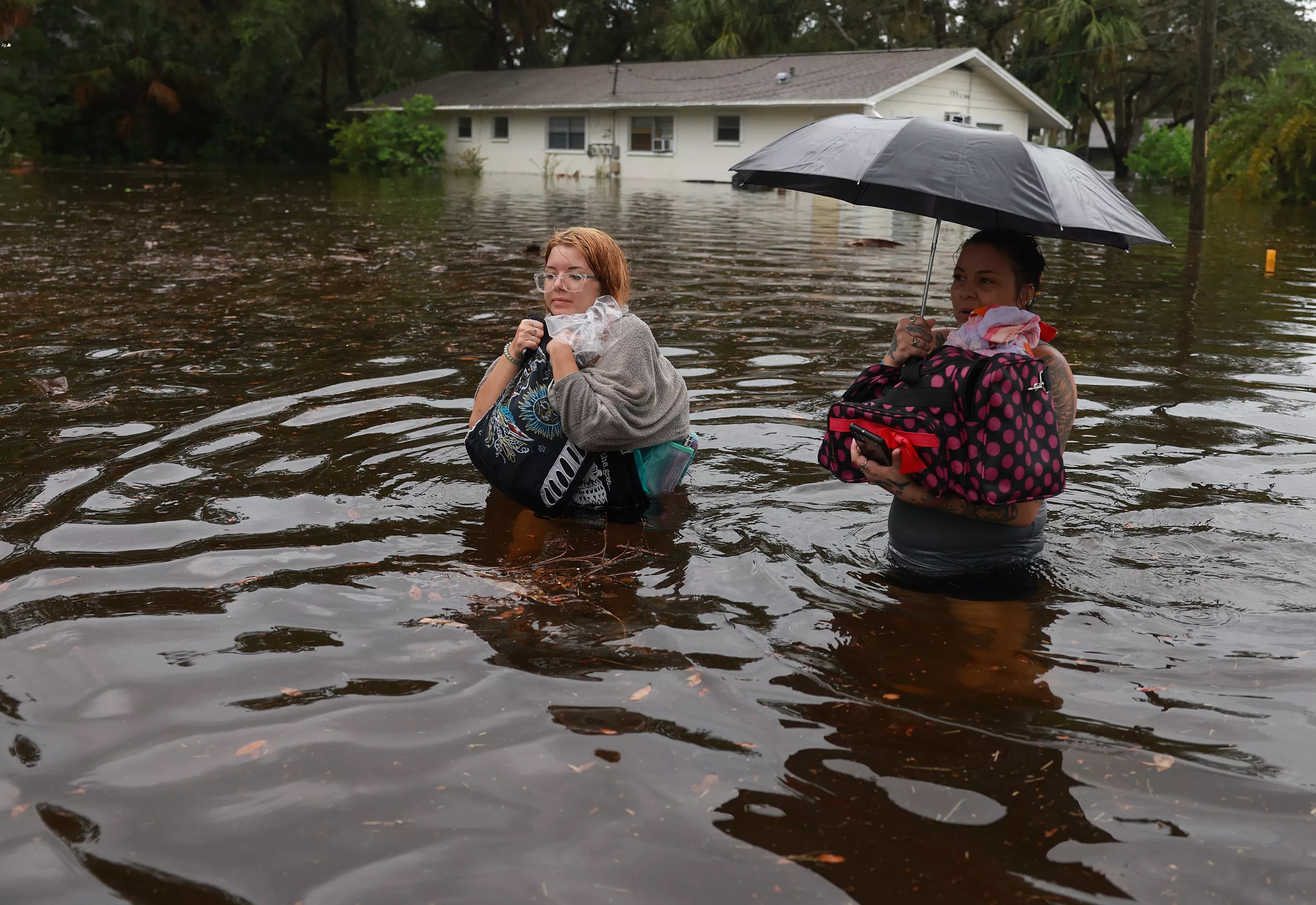
Photo by Joe Raedle/Getty Images

Audio By Carbonatix
The Sunshine State weathered 125 mph winds and a storm surge that engulfed coastal towns when Hurricane Idalia moved onshore Wednesday, August 30, as a Category 3 storm near Keaton Beach.
The storm’s inner bands began battering northwest Florida counties in the early morning, and by noon, scenes of widespread destruction had emerged, with leveled houses and pervasive flooding damage.
In the City of Perry in Taylor County, the eyewall ripped down trees with ease, dropped blinding sheets of rain, and sent buildings careening through the air.
Hurricane Idalia Perry Florida. Outbuildings flying through air, trees falling on power lines, damage in 'eye' of powerful CAT 3 Hurricane Idalia. #HurricaneIdalia pic.twitter.com/4xIBcxstax
— Tijuana Cat Rescue and Sanctuary (@TijuanaRescue) August 30, 2023
Meteorologist and storm chaser Reed Timmer documented the surge waters building up and swallowing the Gulf Coast community of Cedar Key. Roughly twenty-five miles south of the community, structures on Horseshoe Beach were reduced to partially submerged piles of wooden debris.
Incredible #Idalia storm surge 6′ and counting here at Cedar Key, FL pic.twitter.com/8MzaHJpWce
— Jim Cantore (@JimCantore) August 30, 2023
At 10 a.m., more than 260,000 households in Florida were without power. The state has mobilized thousands of National Guard troops to assist in the recovery.
In advance of the storm, county officials warned residents that riding out the hurricane in evacuation zones could prove deadly. Stretching from Franklin to Pinellas, sixteen Florida counties had areas with mandatory evacuation orders.
Despite admonitions to steer clear of the storm surge, some residents on the Gulf Coast ventured out into the streets, including a Tampa Bay man who was seen trying to ride a bicycle through waist-deep floodwaters on the morning of August 30.
WATCH: Despite officials' warnings, a man tried to ride his bicycle around Tampa Bay this morning after the storm surge over 4ft.#Idalia #Hurricane #IDALIAhurricane pic.twitter.com/phPlI68LOG
— Policy Scoop (@policyscoop) August 30, 2023
Idalia reached its peak intensity in the early morning as a Category 4 storm but weakened slightly before landfall. By mid-afternoon, the storm had further weakened into a tropical storm as it moved across Georgia. As of 5:00 p.m., Idalia had maximum sustained winds of 70 mph and was battering Georgia and South Carolina with severe weather.
“Significant impacts from storm surge will continue along the Gulf Coast of Florida within the Storm Surge Warning through this evening. Dangerous storm surge is also expected along the southeastern U.S. coast within the Storm Surge Warning area tonight and Thursday,” the National Weather Service said in an August 30, 11 a.m. advisory.
Last footage from the Horseshoe Beach Camera before it went out #Idalia https://t.co/AlgJJT4fXJ pic.twitter.com/1gZFeCEqvo
— I'm the weatherman, whatever man (@Weathermansam77) August 30, 2023
The National Weather Service said in a 5:00 p.m. bulletin that areas of east central Georgia to eastern South Carolina and eastern North Carolina are forecast to experience flash flooding and river flooding through Thursday.
Rescue operations are ongoing in Florida as first responders fan out in high-water vehicles in search of stranded residents. The Pinellas County Sheriff’s Office released video of first responders driving through Tarpon Springs on a road completely submerged in flood waters.
More footage from Tarpon Springs. Working with fire rescue responding to calls for service. #Idalia pic.twitter.com/kZAeEjapPw
— Pinellas County Sheriff's Office (@SheriffPinellas) August 30, 2023
At an afternoon press conference, Florida Gov. Ron DeSantis said U.S. Coast Guard helicopters were active in the search and recovery efforts.
“Florida Department of Transportation has been conducting cut-and-toss operations starting at the southern part of the state…clearing those roads and then moving all the way up north,” DeSantis said.
Though DeSantis indicated that he had not received reports of direct fatalities, the number of casualties from Idalia’s storm surge remains unclear.
In September 2022, more than 60 people died in Hurricane Ian, most of whom drowned in the storm surge in Lee County. While coastal areas in the county were under an evacuation order, the forecast in the days ahead of Ian’s arrival called for a landfall farther north, which led some Fort Myers-area residents to mistakenly believe they’d be spared. Some residents who survived after trying to ride out the storm on Lee County barrier islands were stranded for days, necessitating an extended rescue and support mission.